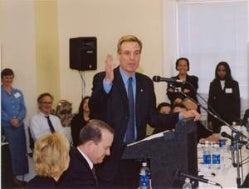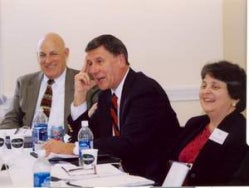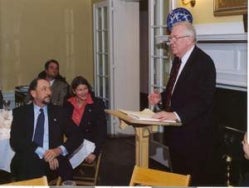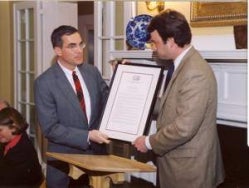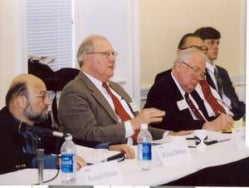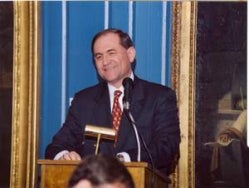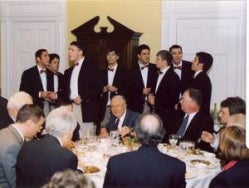Spring 2003 – Communicating in Crisis
University of Virginia
Charlottesville, VA
March 30 to April 1, 2003
At two minutes after six o’clock on the evening of October 2, 2002, a 55-year-old federal government employee named James D. Martin was killed by a single rifle shot as he walked across a supermarket parking lot in Wheaton, Maryland. The next day, five more people were killed in the same mystifying and terrifying way — by rifle fire from an unseen sniper who apparently chose his victims in completely random fashion. Of the six shootings, all but one happened in daylight. All six took place within a few miles of each other, in a busy, densely populated suburban area on the northern edge of Washington, D.C.
Over the next nineteen days, the shooters struck seven more times over a wider area, reaching as far as Ashland, Virginia, 91 miles south of Washington on Interstate 95. Of the seven people shot, four died, and three survived. On October 22, the day of the last shooting, investigators finally identified two suspects and the make and license tag number of the car they were driving. Less than 48 hours later, John Muhammad and Lee Malvo were found sleeping in their car and arrested at a rest stop on Interstate 70 in Maryland.
In the three weeks between the initial shootings and the arrest, a pall of fear fell over the entire Washington region. Nonstop television coverage of the sniper mystery spread the anxiety to the rest of the nation — fear that may have been vicarious but was nonetheless deeply unsettling, particularly as it hit Americans barely a year after the shock of the September 11 terrorist attacks on the World Trade Center and the Pentagon.
The words “terrorist” and “terrorism” were not routinely used to describe the sniper shootings, but in many ways they could have been. (Virginia prosecutors did charge Muhammad under the state’s anti-terrorism law as well as for capital murder, on the grounds that the shootings were acts of violence “committed with the intent to (i) intimidate the civilian population at large; or (ii) influence the conduct or activities of the government of the United States, a state or locality through intimidation.”) Like terrorist violence, the snipers’ attacks were manmade, not natural, confronting society not just with loss of life but with issues of human evil. The snipers also resembled terrorists in using violence unpredictably and aiming at randomly chosen, completely innocent victims, leaving millions of people with the terrifying sense that any one of them could be the next target. The challenges that confronted law enforcement agencies, political leaders, school officials, and communities in the Washington region in October 2002 were similarly close to those that would arise if the area were under a terrorist threat: managing a multi-jurisdictional effort to track down and catch an elusive, deadly opponent; reassuring a fearful public; trying to help people stay safe while maintaining essential services and without unnecessary disruption of daily life; and doing all of those things in the glare of intense, 24-hour news coverage.
Unquestionably, the sniper shootings met the definition of a “critical incident” — “an event that has the potential for causing social trauma and undermining social trust, creating fear that may have impact on community life and even on the practice of democracy.” Accordingly, the Critical Incident Analysis Group of the University of Virginia chose the sniper affair as the case study for its 2003 conference, “Communicating in Crisis.”
Those attending the 2003 conference included present and former senior policymakers; law enforcement officers from federal, state and local agencies; emergency response and homeland security officials at both federal and state levels; and specialists in public health and emergency medicine. Also present were legal scholars, educators, mental health and social service professionals, social scientists, and journalists.
Distinguished Guests
Michael Barkun – is professor of political science in the Maxwell School at Syracuse University. His recent publications include Religion and the Racist Right: The Origins of the Christian Identity Movement (winner of the Myers Center Award), “Project Megiddo, the FBI, and the Academic Community,” and “Defending Against the Apocalypse: The Limits of Homeland Security.” His latest book—A Culture of Conspiracy: Apocalyptic Visions in Contemporary America—will be published this Fall by the University of California Press. He was a coauthor of the CIAG monograph on community shielding, What Is To Be Done? Emerging Perspectives on Public Responses to Bioterrorism. He serves on editorial boards for Terrorism and Political Violence, Communal Societies, and Nova Religio, and is the editor of Syracuse University Press’s Religion and Politics series.
Richard Bonnie – is John S. Battle Professor of Law at the University of Virginia School of Law and Director of the University’s Institute of Law, Psychiatry and Public Policy. He writes and teaches in the fields of criminal law and procedure, mental health law, bioethics, and public health law. Professor Bonnie has been actively involved in public service throughout his academic career. In 1991, Professor Bonnie was elected to the Institute of Medicine of the National Academy of Sciences, and he currently serves on the Institute of Medicine (IOM) Board on Neuroscience and Behavioral Health. Professor Bonnie has served as an advisor to the American Psychiatric Association’s Council on Psychiatry and Law since 1979, and received the APA’s Isaac Ray Award in 1998 for contributions to forensic psychiatry and the psychiatric aspects of jurisprudence. In October 2002, the IOM awarded Professor Bonnie a medal for outstanding service.
Michael R. Bouchard, M.S. – Special Agent in Charge, Baltimore Field Division, Bureau of Alcohol, Tobacco and Firearms was Appointed Special Agent in Charge/Division Director of the Baltimore Field Division on April 7, 2002. Areas of responsibility include the criminal and regulatory enforcement missions relating to alcohol, tobacco, firearms, explosives and arson in Maryland and Delaware. Law enforcement career began as a police officer in 1979. Field positions held—Resident Agent in Charge, Springfield, Massachusetts, and Assistant Special Agent in Charge, Baltimore Field Division. Headquarters positions—Special Agent in Charge, Resource Management Branch; Special Agent in Charge, Arson Enforcement Branch; and Chief, Arson and Explosive Programs Division, Special Agent in Charge, National Response Team. Handled logistics—ATF response to Oklahoma City bombing. Handled logistics—ATF resources, Church Fire investigations. ATF/ Treasury representative for two years during development of the DOJ 5 year Coordinated Counter-Terrorism Response Plan Oversight over ATF NRT resources during “Operation TOP-OFF” Portsmouth, New Hampshire. Managed ATF resources at the Pentagon crash site.
Colonel V. Stuart Cook – was born in Richmond, Virginia and has been a life-long resident of the Richmond area, living in Hanover County for over 40 years. Colonel Cook joined the Richmond Bureau of Police on June 21, 1965, and worked his way through the promotional system to the rank of Major. While at the Richmond Bureau of Police, he worked in every Division and served as Deputy Chief of Investigative Operations for 12 years. Colonel Cook was appointed Sheriff of Hanover County by Judge Richard H. C. Taylor on August 2, 1990. In October, 2002, Colonel Cook successfully led the Richmond Metro area Sniper Task Force. Prior to the attack, he had foresight in the possibility that localities along the I-95 corridor may become potential targets for the snipers and was instrumental in devising a pre-plan to address an incident should it occur. On October 19, 2002, the Town of Ashland, which lies in Hanover County, became the victim of the snipers. As a result, the plan of put into effect resulting in key factors leading to the arrests of the snipers.
James S. Gilmore, III – is a former Governor of Virginia (1998-2002) and a Partner at the law firm of Kelley, Drye, and Warren (www.kelleydrye.com). He is practicing corporate and technology law and providing advice to clients on homeland security issues in the areas of public relations, information technology, and international relations. Since 1999, former Governor Gilmore has been Chairman of the Congressional Advisory Panel to Assess Domestic Response Capabilities for Terrorism Involving Weapons of Mass Destruction, also known as the “Gilmore Commission.” This national panel was established by Congress to assess federal, state, and local governments’ capability to respond to the consequences of a terrorist attack. The panel submitted its findings to the President and Congress each of the past four years and is extended until December 15, 2003. This Commission was also influential in developing the Office of Homeland Security.
Steven M. Gorelick, Ph.D. – is Vice President for Institutional Advancement at The City University of New York Graduate Center. He also serves as Adjunct Professor of Sociology and Journalism at Hunter College, CUNY, where he teaches courses on press coverage of violence and the history and methods of propaganda. He specializes in sociology of culture and mass media. His major research interest is the social and moral panic that emerges in the aftermath of high profile crimes of violence as society, the press, the criminal justice system cope with the resulting social trauma and extraordinary media attention. His academic publications have appeared in the Journal of Crime and Delinquency, the Media Studies Journal of The Freedom Forum at Columbia University, and Children’s Beat: A Journal of Media Coverage.
Edwin Meese III – holds the Ronald Reagan Chair in Public Policy at The Heritage Foundation, a Washington-based public policy research and education institution. He is also the Chairman of Heritage’s Center for Legal and Judicial Studies. Additionally, he is also a Distinguished Visiting Fellow at the Hoover Institution, Stanford University, California, and a Distinguished Senior Fellow at The University of London’s Institute of United States Studies. He served as the 75th Attorney General of the United States from February 1985 to August 1988. As the Nation’s Chief Law Enforcement Officer, he directed the Department of Justice and led international efforts to combat terrorism, drug trafficking and organized crime. In 1985 he received the Government Executive magazine’s annual award for excellence in management.
Mark Warner – was elected Virginia’s 69th governor in November of 2001. He received his BA from George Washington University in 1977 and law degree from Harvard Law School in 1980. Since his inauguration in January 2002, he has taken a business-like approach to the challenges of the sluggish national economy and a $6 billion revenue shortfall in Virginia. Before he became governor, this successful businessman started the Virginia Health Care Foundation, which has provided health care to more than 400,000 underserved Virginians in rural and urban areas. In 1997, he developed the Virginia High-Tech Partnership, which helps students from Virginia’s five Historically Black Colleges and Universities pursue technology careers through a summer internship and job placement program.
Key Panels and Discussions
The goal of their discussions was not just to review the events of the Washington sniper case but to relate them to broader themes. Three major issues emerged: (1) problems of managing a critical incident that involves multiple jurisdictions and levels of government; (2) public communication in a time of fear; and (3) shaping organizational, cultural and community responses that will mitigate damage and foster resilience.
If the sniper affair was a model for examining critical incident response, there was this sobering fact to consider: a 22-day reign of terror affecting millions of Americans had been caused by two men with one easily available low-tech weapon, acting alone without any outside support and with hardly any funds of their own. As frightening as the sniper event had been, it was easy to imagine even more alarming possibilities. “What if there were three sniper teams?” one CIAG speaker asked. “What if there were more of them, what if you added a couple more or ten more jurisdictions?” If “two guys running around in a worn-out Caprice” could put so much strain on law enforcement resources and public nerves, he added, “what happens if you have a much better organized effort against us?”
Representative Insights
“The role of crisis communication in these events is ambiguous. It is supposed to make the landscape less fearful by providing accurate reporting in place of unsubstantiated rumors, by providing warnings of danger and by giving advice that may protect potential victims. Whether or not it accomplishes these tasks, however, it also becomes part of the landscape of fear. Color-coded alert levels, for example, became part of the landscape they purported to monitor. Communicators, especially official government communicators, are meant to stand outside of the landscape and reduce the level of fear by enhancing a sense of control. For several reasons, however, their messages become part of the very landscape that they seek to modify.” – Mike Barkun
“A lot of good work was done, a tremendous amount of work and all ended well, but we hope if we ever have one of these again, it is going to be much smoother. Our task force was not a picture of the way you operate a task force, believe me, and I will be the first to admit it. The day the two arrests went down, we said we are not breaking this task force down until we critique what we did. We are going to talk about the good things that this task force did, we are going to talk about the things that we did but could have been better, we are going to talk about the things that we totally screwed up on. Believe me we did that.” – Stuart Cook
“You also have to develop a relationship with the media — I would say with select numbers of the media, because you need to know who is sound and reliable and who is not. Much of the media today, particularly when we don’t have correspondents embedded in capitols around the world the way we used to, is ill-informed and really not very serious, I am afraid. In the Beirut civil war, we were blessed with an unusually high number of really quality media people whom I dealt with quite a bit. I found that they had information I didn’t have, they knew about things I couldn’t move around and learn about, and I had information they didn’t have. This led us to a productive relationship, not compromising anybody’s integrity but serving both interests. We talked to each other before we needed something so that we had a baseline of understanding.” – Ambassador W. N. Howell
“Another problem with television coverage, for example in Iraq, is that instant coverage is also instant worry. I can cite a personal example. Two of our sons were in combat in the Persian Gulf and as incidents would unfold I would get calls from their wives and others, and I had that worry too. Instant coverage causes an enormous instant worry for parents and family. Now that can very quickly get translated into erosion of support. I am sure that the administration is very concerned about that.” – John O. “Jack” Marsh Jr.
“The important thing is to establish the command structure so that everybody knows what is happening, and the detectives that are going out to investigate know who has the authority to give them assignments, and that sort of thing. The way they adapted the incident command system to this particular case was really well done, I think. In most law enforcement situations, crime investigation has not been particularly susceptible to incident command structures, so this was really a revolutionary development and I think it worked out extremely well.” – Edwin Meese III
“We have a control mechanism on greed, the Securities and Exchange Commission. We don’t have a control mechanism over the communicators or over the journalists. I am not suggesting that we have an SEC, some kind of a control over the communications network, but perhaps there are ways to establish some norms here, to say that there are certain things are going beyond the pale.” – Lt. General Edward L. Rowny (Ret)
“One of the speakers mentioned letting the national media control the story. As I look around this room there are a number of people who have been involved with issues in which the national media had a strong interest. It is certainly true that you cannot control the media, but it is equally true, I think, that you cannot allow the media to control your project, whether it is an investigation or something else.” – George Terwilliger
“The challenge was how to grapple with that in a leadership role in terms of what you communicated, how you communicated, how to do your job as leader of the commonwealth but being mindful of the law enforcement advice we were getting that said, don’t go out and be too aggressive in your comments because that might spur the sniper or snipers into additional action.” – Mark Warner, Governor
Images
- Hon. Mark Warner, Governor of Virginia, addresses conference participants.
- John Noftsinger and Suzanne Spaulding greet Governor Mark Warner.
- Edwin Meese addresses conference participants during Monday night’s dinner at UVa’s Colonnade Club.
- Delegate Robert Hurt of the Virginia House of Delegates presents CIAG Executive Director Greg Saathoff with a Virginia General Assembly Commendation in recognition of CIAG’s work on “Community Shielding.”
- Michael Barkun, Jerry Jones and Edwin Meese
- Hon. James Gilmore III, former Governor of Virginia, addresses conference participants during Sunday night’s dinner.
- The Virginia Gentlemen entertain everyone during dinner with their a capella singing.

